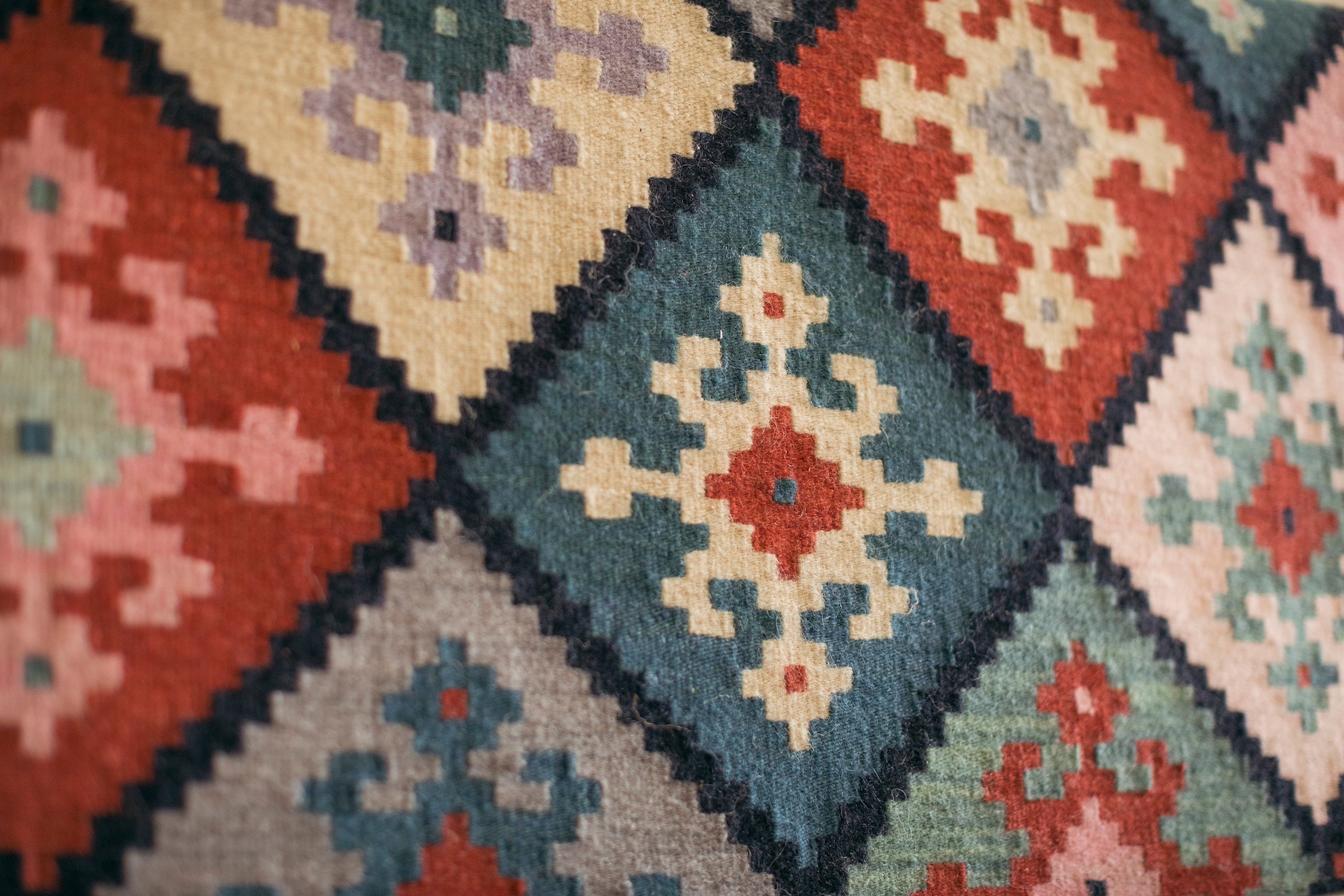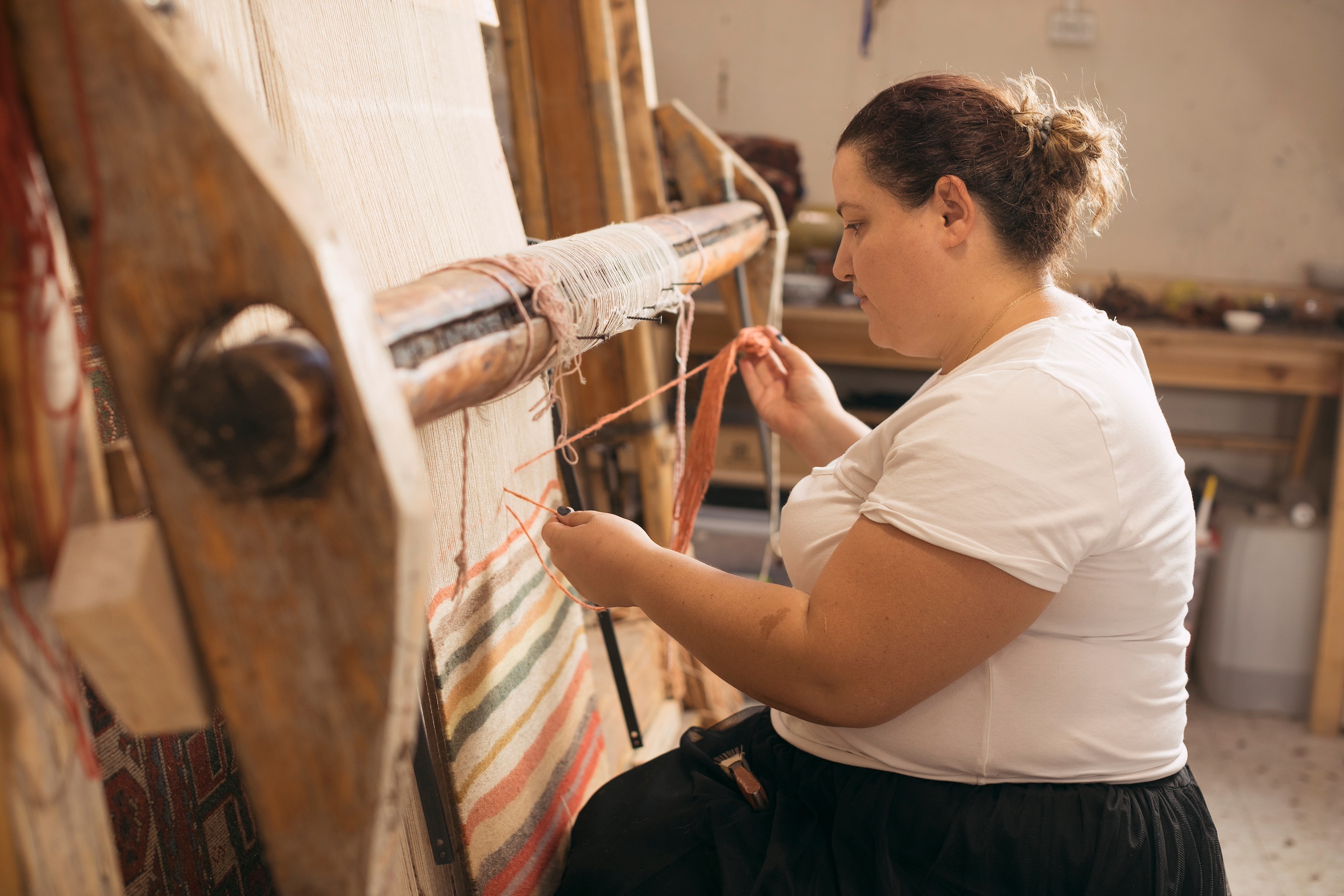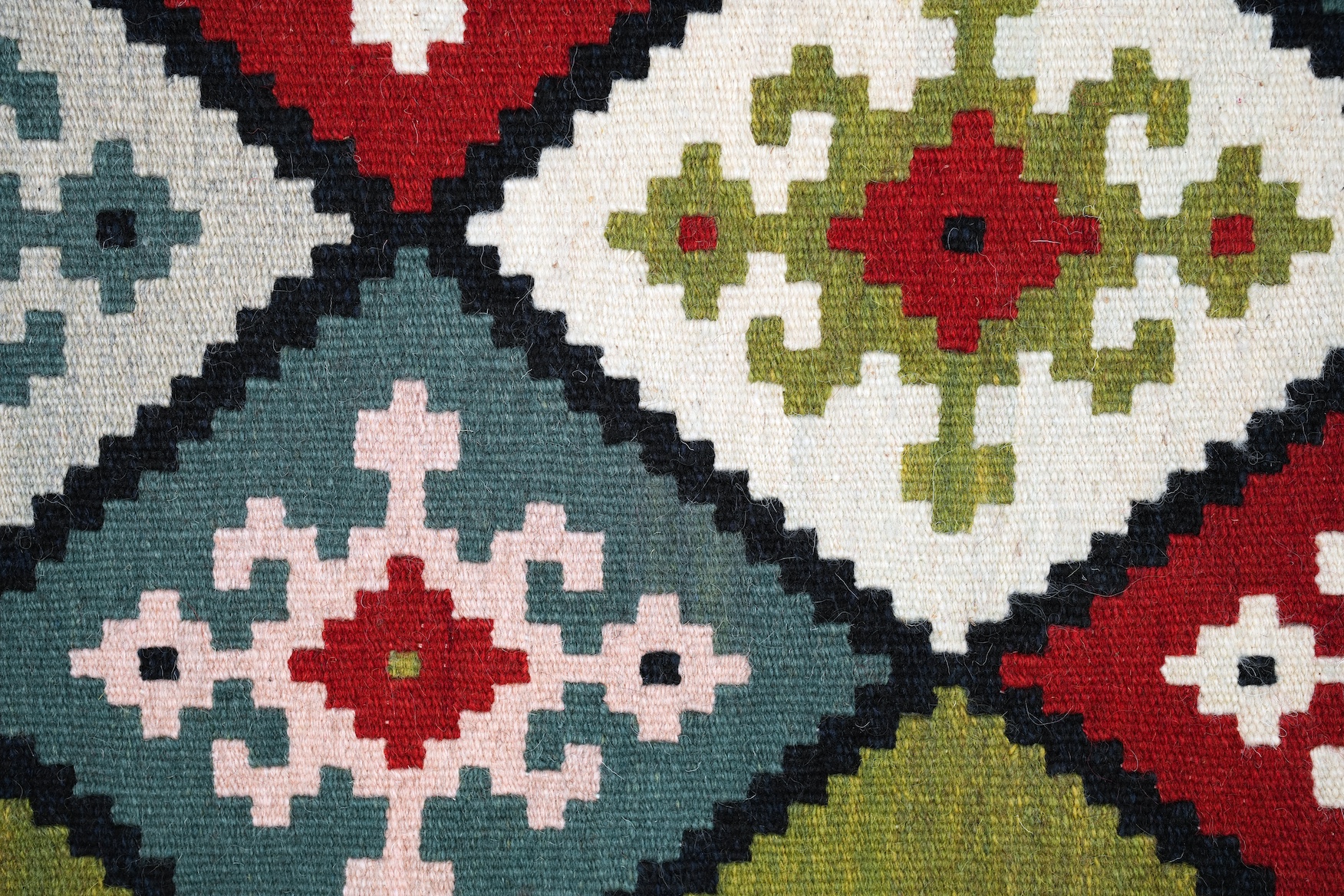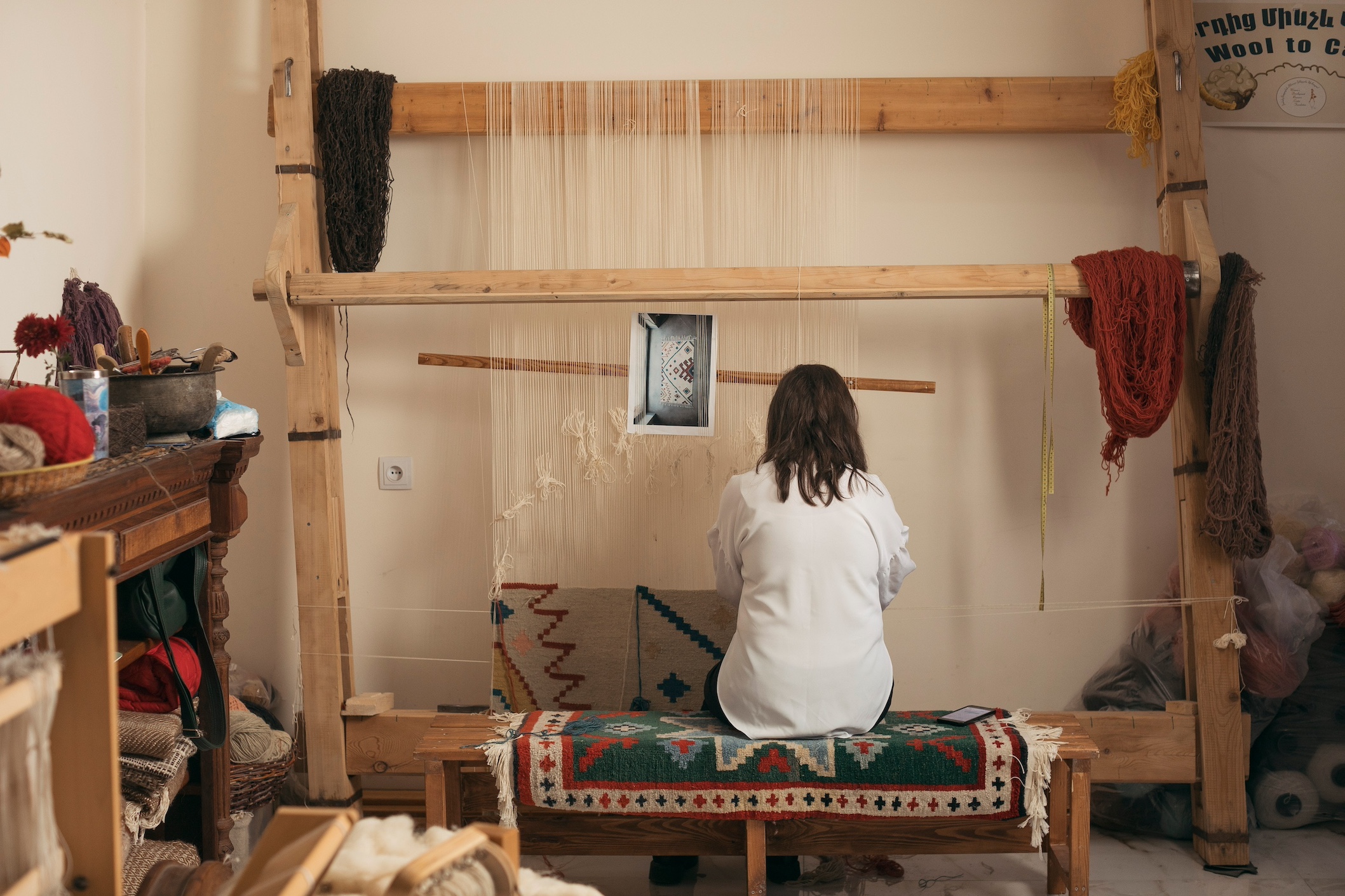The following is a guest post by Kyle Khandikian. He is the founder of The Rug Code, an online shop combining traditional rug making techniques with modern design that celebrates the thousands of years of coded stories and wisdom woven into each knot. Photographs courtesy of The Rug Code.
***
When I moved to Yerevan from Los Angeles eight years ago, I was struck by the bold colors and geometric ornaments of the local rugs I saw all around me – on the floors and walls of my host family’s apartment, decorating local restaurants and cafes, displayed in museums, and for sale in antique shops and at outdoor markets. Traditional rug patterns can be seen on the facades of Soviet apartment buildings in downtown Yerevan. There’s even a huge rug motif in the center of the roundabout in Republic Square that can only be seen from the sky.
Rugs are an intrinsic part of local culture; they “speak,” so to speak, to local people and those who admire them. There’s something about the red, blue, white, yellow, and black knots of a traditional rug coming together as abstract, geometric ornaments, much like the tiles of a mosaic, that move me. Rugs are not just objects of aesthetic beauty for Armenians, but of sacred meaning, and their ornaments are symbolic. In Gandzak (present day Ganja, Azerbaijan), Armenians gave birth on rugs.
Up until the early 20th century, Armenian villagers wrapped the deceased in flat woven rugs before surrendering them back to the earth, a practice dating to the Bronze Age. The rug makers I meet today remember the time when nearly every home across Armenia had looms, when rugs were woven for personal use and to mark major life events – marriage, birth, death. Rugs are not just symbols of life for Armenians. They are life itself. But as a mere admirer of Armenian rugs, the meanings of their ornaments initially eluded me.
My quest to decode Armenian rugs first began at the Vernissage market, a popular place to purchase rugs in downtown Yerevan centrally located near Republic Square. The stalls come alive during the summer months with tourists looking for gifts or keepsakes to take home, and one can find colorful textiles, handmade jewelry, drums and woodwind pipes, works of local painters, wood-carved chess and backgammon sets, ceramics and silverware, Soviet paraphernalia galore, from pins and stamps to antique samovars and record players, and of course, rugs. Perusing the literal trunks of sellers’ cars, they each seemed to have their own interpretations of the rugs they were selling.
When I’d pay a visit to admire their rugs and maybe make a purchase if I found something extra special, more often than not it felt like vendors told me what I wanted to hear about the rugs that caught my eye, rather than the truth about its origins. “It’s from Western Armenia,” (present day eastern Turkey, where I and many diasporan Armenians trace back our heritage) or, “It’s over 100 years old,” were common phrases I’d hear, appeals to my nostalgia for a lost homeland in the hopes that I’d make a purchase. Without traceability of these rugs or expert knowledge, shoppers at Vernissage only have vendors’ words to go by, and many rugs at the market are brought from other countries, where it’s less expensive to produce rugs, and resold as “Armenian.”
Understanding and interpreting the meanings of rug ornaments is a monumental task that requires a bit of everything – ethnography, history, art, religion, geography, and linguistics, to name a few. It’s an endless process of reading, studying, consulting, writing, and re-writing. Making the meanings of traditional Armenian rug ornaments accessible is one of the reasons why I created The Rug Code, an online shop where anyone around the world can order an Armenian rug directly from village-based weavers in an easy and transparent way. Our mission is simple: deliver high-quality, handmade rugs from Armenia, sharing where our rugs come from, what they’re made of, who makes them, and what their ornaments represent. On The Rug Code shoppers can read summaries of my research findings about each of the handmade pieces available for order – initial because Armenian ornaments and symbols are a tremendously rich universe of their own, and I’m always learning something new about rugs and ornaments.
 But The Rug Code has a bigger, more urgent mission. Though Armenia has a 4,000-year-old weaving tradition, the tragic reality is that this once widespread artistic and spiritual practice is on the verge of disappearing from the country today. Everywhere I go, everyone I speak to says the same thing: no one weaves in Armenia anymore. Young people in particular are not interested in taking up rug making because it’s not seen as a way to create a prosperous living. Those who do know how to weave don’t, because they lack the visibility necessary to reach customers. The Rug Code is solving this problem, telling the human stories of village-based weavers and their handmade creations one made-to-order rug at a time.
But The Rug Code has a bigger, more urgent mission. Though Armenia has a 4,000-year-old weaving tradition, the tragic reality is that this once widespread artistic and spiritual practice is on the verge of disappearing from the country today. Everywhere I go, everyone I speak to says the same thing: no one weaves in Armenia anymore. Young people in particular are not interested in taking up rug making because it’s not seen as a way to create a prosperous living. Those who do know how to weave don’t, because they lack the visibility necessary to reach customers. The Rug Code is solving this problem, telling the human stories of village-based weavers and their handmade creations one made-to-order rug at a time.
Our first collection, Improvisia, was designed by Goris Handmade, a collective of woman weavers based in Verishen village in the Syunik province, Armenia’s southernmost region bordering Iran. The ornaments the weavers chose to work with when composing each rug’s design are traditional and widely used across Armenia, while the bright colors and compositions themselves are not. One of the weavers, Ani, told me, “I know Armenian ornaments well. I recognize them, so they come instinctively, I don’t need a drawing or map. These rugs that we’re weaving – I don’t look at pre-designs, I simply weave,” hence the collection’s name, Improvisia.
The Goris Handmade workshop is modest, occupying a room of Verishen’s Soviet-era House of Culture. Once an active center for arts and recreation, the building would be abandoned were it not for the four wooden looms, the spinning wheels, the colorful yarn balls handspun using wool sourced from shepherds in nearby villages, and of course the women themselves, who are keeping traditional rug and textile making alive.
Weaving is a meditative practice for the women, as well as a way to support their families. “When you weave you find yourself in another world. You forget about your worries. Sometimes you don’t even hear the conversations of the weavers next to you, because you’re somewhere else while you’re weaving. You’re always ‘in’ the rug when you weave. You’re a part of it,” Anush, another weaver, told me.
Ani added to the sentiment: “You weave a rug with different emotions, and you put those emotions in the rug. From the beginning to the end, you are with your emotions, you can’t ‘just weave.’ A rug contains the energy and nature of the weaver, their experiences. The weaver is inside the rug.”
The act of weaving has taken on new meaning for the collective in the aftermath of the second Artsakh (Nagorno-Karabakh) war in 2020 and the forced displacement of Artsakh’s entire Armenian population in September 2023. Their modest village workshop was used to temporarily house refugees from Artsakh fleeing Azerbaijan’s military attack. One weaver, Milena, and her family lost their home in Berdzor, in 2020. Like thousands of families from Artsakh, they are now rebuilding their lives in Armenia.
“Weaving isn’t only a source of income. It’s also a way to deal with stress after the war. This workshop, its environment, the people here… After the war… I had no inspiration following the war, but after coming here my inspiration started to awaken little by little. Seeing the threads, interacting with these women, reawakened my inspiration. I wanted to weave again,” Milena told me.
Weavers like Ani, Anush, and Milena are bearers of the vernacular knowledge of local rug making practices and symbology now under threat in Armenia. But not all weavers know the meanings of rug symbols; many simply weave. To create a complete picture of the symbols used in our rugs, I used both the knowledge of local weavers and that of experts, from designers, collectors, and appraisers to academics. I read both local academic publications from the Soviet and post-Soviet periods, as well as international literature on Armenian, Caucasian, Iranian, and Anatolian rugs. I consulted with experts in the field to confirm whether or not my research was accurate. One expert was Lilia Avanesyan, an ethnographer and researcher at the History Museum of Armenia. Her book, The Etymology and Semantics of Ornaments in Armenian Carpets, was one of the sources I referenced when trying to decode the ornaments of The Rug Code’s first collection.
Avanesyan argues in her book that when studying Armenian rug ornaments and their meanings, certain generalizations can be made: they are archaic and come to us from the very distant past; they can be found on monuments and other material cultural artifacts of the Armenian Highlands; their form and appearance is directly linked to the economies and ways of life of ancient Armenians, namely agriculture and the natural environments of the Armenian Highlands; and that they are symbols or ideograms bearing meaning.
Avanesyan’s research draws a direct link between ornaments and the natural cycle of life. For millennia, fleece, wool, and woolen textiles like rugs maintained a cult-like status among the peoples of the Armenian Highlands and the wider region, used as sacral objects in religious rites during the time of the Kingdom of Van (Urartu) according to Avanesyan, and even for medicinal purposes in villages to this day, as I was told by the weavers of Goris Handmade.
When studying the ornaments used in our first collection, I found that every ornament is directly or indirectly related to life and conception. One of our rugs, Pakhlava, features alternating, multicolored checkers with eight-pointed stars called “super crosses,” “sun crosses,” or “apple crosses” in Armenia, symbolizing rebirth, revival, and well-being. The eight points of these stars are interpreted to represent the four cardinal and four ordinal directions of the world. The significance of the four cardinal directions, represented by the super crosses’ arms, relates to founding myths of the universe, where God is said to have created the world and the four elements of the cosmos: earth, air, water, and fire. Arto Tavukciyan, a leading Armenian rug collector who runs the popular online platform Hye Antiques confirmed this interpretation.
However, Avanesyan has a different interpretation of these sun crosses. She says that they are not stars but budding seeds or blooming flowers. Seeds, plants, and flowers, like stars, are symbols of life, specifically of reproduction. One might wonder why the name Pakhlava? According to the weavers, they call it Pakhlava because the checkered pattern of the design looks like the surface of a tray of Armenian pakhlava, a sweet treat similar to baklava.
Every rug has a complex story that extends from the far reaches of history to the present day, from different corners of the Armenian Highlands and the wider region to modern Armenia, and from the weaver who made it to the person or people who later possess it. Some even have multiple or conflicting stories, like Pakhlava.
Another rug, Dragon Bloom, features a blooming red flower in its center that symbolizes fertility, and dark blue rudimentary dragons (the four rows of “Z” shaped symbols), in its composition, represent water. Again, Avanesyan and Tavukciyan have differing opinions about the central ornament. Tavukciyan and many others liken the hooked arms of the red ornament to dragons, guardians of water and mighty creatures of great wisdom, prophetic grace, and at times calamity according to Armenian tradition.
In local folk imagination, dragons live deep beneath the earth’s surface or in the depths of the sea, and bring disastrous storms and floods with them when they emerge. As guardians of water, a fundamental element necessary for life, they have the ability to block flowing water and rain, causing droughts. Dragons and snakes play an important role in Armenian ornamentation and symbology. Avanesyan doesn’t see dragons in the central ornament but rather another blooming flower with its pollen-producing stamens (Tavukciyan’s dragons). When viewed horizontally, one can see Avanesyan’s flower.
Are ornaments like these exclusively Armenian? Not necessarily. Like all cultural artifacts, they’ve undergone multiple exchanges and transformations over the centuries as different civilizations have come and gone in the Armenian Highlands, Anatolia, and the Iranian Plateau. Avanesyan and Tavukciyan’s different interpretations of the same ornaments further reflect their various meanings.
But Armenians’ lack of statehood in recent centuries means that the rugs they created were often attributed to others once they were cut from their highland looms. Then came the Armenian Genocide, an unspeakably horrific blow to millennia of Armenian civilization, including traditional rug-making practices.
When I asked Avanesyan what it’s like to trace the origins of Armenian rugs and ornaments post-genocide, she likens it to “searching in the dark.” But scholars like her are able to do a remarkable amount of tracing, using a combination of the studies previously mentioned, as well as comparative analysis.
During one of our meetings, a repair worker at the museum overheard our conversation and showed Avanesyan a family rug that had been brought to modern Armenia from Western Armenia. “Is your family from Van?” she asked. “Alashkert,” he said, known as Eleşkirt in eastern Turkey, just 130 kms away from the shores of Lake Van and 150 kms from the border with Armenia. “Are you from the Sevan basin?” she followed up. “Yes,” he said.
As it turns out, many survivors of the Armenian Genocide originally from Alashkert settled around Lake Sevan in modern Armenia. His family, like many others, traveled the forced road of exile with their most valuable possession and one that would have provided warmth and a makeshift shelter along the way: a rug.





















